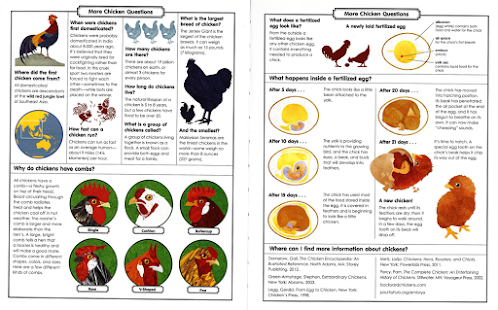A Chicken Followed Me Home is the perfect starter book for a child looking to raise their own chickens, or who would simply like to learn more about the life cycle of these domestic fowl. This expository book pairs vibrant collage-style illustrations with straightforward text to answer common questions about keeping chickens.

(Page, 2015, p.10-11)
In the first half of the book, readers can learn about what chickens eat, where they sleep, some of the common chicken species, and the differences between a hen and a rooster. The last half of the book is largely taken up by the life cycle of the chicken, from egg fertilization, through hatching, all the way to adulthood.

(Page, 2015, p.24-25)
The final spread answers a few further questions, including a more in-depth look about what happens inside of an egg while a chick is growing. There is also a section with additional resources for readers who would like to learn more about chickens.
 |
| (Page, 2015, p.32-33) |
A Chicken Followed Me Home received glowing reviews from professional reviewers, including starred reviews from both School Library Journal and Publisher’s Weekly. This lively informational book is short enough to read to early elementary children, or even attentive preschoolers, while having enough information to satisfy older readers’ curiosity. While not a deeply in-depth look into chicken raising, it would make an excellent book to read together before buying chicks to raise, or a field trip to the farm.
Books and websites for further research:
 A Kid's Guide to Keeping Chickens by Melissa Caughey. Published in 2015 by Storey Publishing. 144 pages. Recommended for ages 8-12 years.
A Kid's Guide to Keeping Chickens by Melissa Caughey. Published in 2015 by Storey Publishing. 144 pages. Recommended for ages 8-12 years.
This in-depth resource covers everything a child or family would want to know about keeping their own chickens. Filled with recipes, crafts, and lots of photographs, this would be a great book for your next step into chicken research after reading A Chicken Followed Me Home.
 Chicks & Chickens by Gail Gibbons. Published in 2005 by Holiday House. 32 pages. Recommended for ages 4-8 years, lexile 570.
Chicks & Chickens by Gail Gibbons. Published in 2005 by Holiday House. 32 pages. Recommended for ages 4-8 years, lexile 570.
This title would make an excellent companion book to A Chicken Followed Me Home. This book covers a bit more information on chicken information, breeds, and life cycles, with text and illustrations that would be appealing to a young elementary school child.
 Hatching Chicks in Room 6 by Caroline Arnold. Published in 2017 by Charlesbridge. Recommended for ages 3-7 years, lexile 590.
Hatching Chicks in Room 6 by Caroline Arnold. Published in 2017 by Charlesbridge. Recommended for ages 3-7 years, lexile 590.
With photographs and text that are appealing to preschoolers and kindergartners, Hatching Chicks in Room 6 would be an excellent choice to read to a classroom doing a unit on chickens, or hatching their own chicks in the classroom.
Website - Raising Happy Chickens. Located at:
https://www.raising-happy-chickens.com/
Raising Happy Chickens is a comprehensive guide for anyone who would like to raise their own chickens at home. With beginner guides, reviews on equipment, and links to help users find out about their local laws regarding backyard chickens, this website covers the basics and more to keeping your own chickens.
Website - DK Findout! Chickens. Located at: https://www.dkfindout.com/us/animals-and-nature/domesticated-animals/chickens/
With interactive vocabulary and an engaging video, this subject guide from DK makes for a fun few minutes of exploring and learning about chickens.
References:
Page, R. (2015). A chicken followed me home: Questions and answers about a familiar fowl. Beach Lane Books.











































